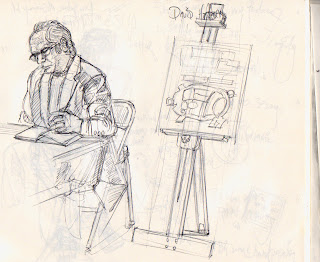


In his introduction, Kuper outlines his approach to the original book, which featured extensive use of the n-word and worked from a general worldview that European males are the forgers of civilization (even if they suffered a “soul had gone mad” for their efforts), explaining that “by choosing a different point of view to illustrate, otherwise faceless and undefined characters were brought to the fore without altering Conrad’s text.” There is a moment when a scene of indiscriminate shelling reveals the Africans fleeing, and there are some places where the positioning of the Africans within the panel gives them more prominence, but without new text added to fully frame the local people, it’s hard to feel that they have reached equal footing. Marlow’s trip to what was known as the Dark Continent exposes him to the frustrations of bureaucracy, the inhumanity employed by Europeans on the local population, and the insanity plaguing those committed to turning a profit. This well-connected vagabond then regales his friends with his boyhood obsession with the blank places on maps, which eventually led him to captain a steamboat up a great African river under the employ of a corporate empire dedicated to ripping the riches from foreign land. Ultimately, she concludes, “I figure if I can put all the abnormality, perversion and zaniness onto paper and still manage to be a partially normal mother to my kids, I will have done all right.”Ĭartoonist Kuper ( Kafkaesque, 2018, etc.) delivers a graphic-novel adaptation of Joseph Conrad’s literary classic exploring the horror at the center of colonial exploitation.Īs a group of sailors floats on the River Thames in 1899, a particularly adventurous member notes that England was once “one of the dark places of the earth,” referring to the land before the arrival of the Romans. Drawn at age 20, the three-step “Try to Do Away With Your Negative Thoughts” is as cathartic as cartooning gets. Maybe if adults really want to read it they can!"), and through adolescence she used her art as a way to process not only the typical traumas but the shadow cast by a famous father (“The Legend”). By ten, she had her own comic strips and books (“WOW Comics! For kids only. By seven, her imagination was capable of rendering a girl turning into a pizza slice, and by eight she had mastered a more realistic manner of drawing that could pass for a high schooler’s. What her mother calls her “wacky personal style” is fully evident by the age of four (“Family Peeing”). But, as her proud papa recognizes, the real fascination with this book is the way it allows the reader “to track the development, the evolution, of a given human being through the medium of drawing…” He adds: “One can look at this book as a sort of clinical study, a psychological textbook.” The apple didn’t fall far from the familial cartooning tree, as the maturation of Sophie’s style attests, but this progression would be significant even if the artist had a different surname and background. Crumb and Aline Kominsky-Crumb, who made the selections with their daughter from thousands of previously unpublished drawings, saved and dated by her “compulsive archivist” father. The book’s publication will initially draw attention because of the 29-year-old artist’s parents, R. This is a unique volume, an artistic autobiography of year-by-year sketchbook drawings, ranging from the scrawls of a two-year-old to a fully developed vision.


 0 kommentar(er)
0 kommentar(er)
